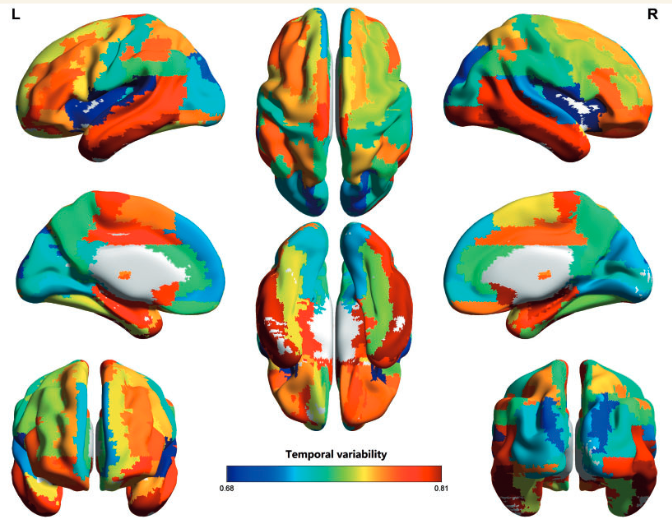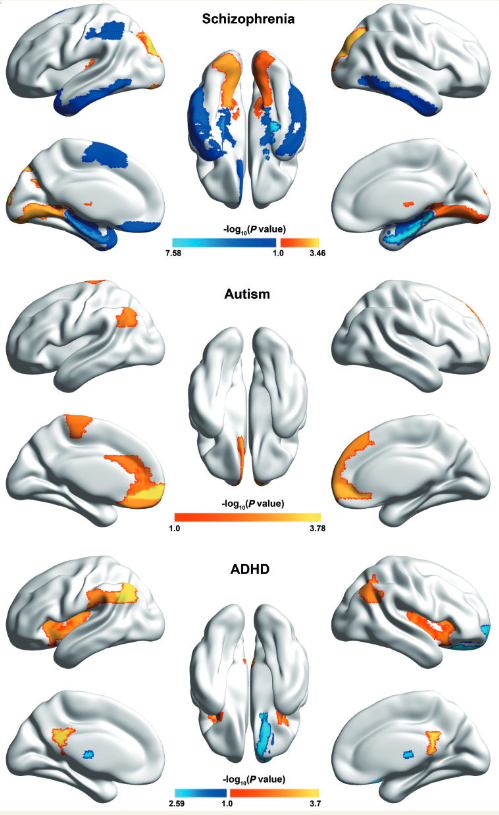Study reveals new measure of intelligence involving temporal variability of brain areas
August 1, 2016

Whole-brain temporal (time) variability is high in areas associated with intelligence and low in sensory cortices (credit: Jie Zhang et al./Brain)
A new study of human intelligence by University of Warwick researchers and associates at nine universities in China and NEC Laboratories America has quantified the brain’s dynamic functions, identifying how different parts of the brain interact with each other at different times, they reported in the journal Brain.
The more variable a brain is, and the more its different parts frequently connect with each other, the higher a person’s intelligence and creativity are, the researchers found .
Specifically, using resting-state MRI analysis of 1180 people’s brains in eight datasets around the world, the researchers discovered that the areas of the brain associated with learning and development, such as the hippocampus, show high levels of temporal variability — meaning that they change their neural connections with other parts of the brain more frequently, over a matter of minutes or seconds. But regions of the brain that aren’t associated with intelligence — visual, auditory, and sensory-motor areas — show small variability and adaptability.
This more accurate understanding of human intelligence could be applied to the construction of advanced artificial neural networks for computers, with the ability to learn, grow and adapt, the researchers suggest. Currently, AI systems do not process the functional variability and adaptability that is vital to the human brain for growth and learning, they note.
Improving mental-health treatments

Brain regions showing significant variability differences between patients with mental disorders and matched healthy controls. Blue indicates that the variability of patients is lower than that of controls, and red-to-yellow indicates the opposite. (credit: Jie Zhang et al./Brain)
This study may also have implications for a deeper understanding of another largely misunderstood field: mental health. Altered patterns of variability were observed in the brain’s default network with schizophrenia, autism, and attention deficit hyperactivity disorder (ADHD) patients.
Knowing the root cause of mental-health defects may bring scientists closer to treating and preventing these conditions in the future, according to the researchers.
Abstract of Neural, electrophysiological and anatomical basis of brain-network variability and its characteristic changes in mental disorders
Functional brain networks demonstrate significant temporal variability and dynamic reconfiguration even in the resting state. Currently, most studies investigate temporal variability of brain networks at the scale of single (micro) or whole-brain (macro) connectivity. However, the mechanism underlying time-varying properties remains unclear, as the coupling between brain network variability and neural activity is not readily apparent when analysed at either micro or macroscales. We propose an intermediate (meso) scale analysis and characterize temporal variability of the functional architecture associated with a particular region. This yields a topography of variability that reflects the whole-brain and, most importantly, creates an analytical framework to establish the fundamental relationship between variability of regional functional architecture and its neural activity or structural connectivity. We find that temporal variability reflects the dynamical reconfiguration of a brain region into distinct functional modules at different times and may be indicative of brain flexibility and adaptability. Primary and unimodal sensory-motor cortices demonstrate low temporal variability, while transmodal areas, including heteromodal association areas and limbic system, demonstrate the high variability. In particular, regions with highest variability such as hippocampus/parahippocampus, inferior and middle temporal gyrus, olfactory gyrus and caudate are all related to learning, suggesting that the temporal variability may indicate the level of brain adaptability. With simultaneously recorded electroencephalography/functional magnetic resonance imaging and functional magnetic resonance imaging/diffusion tensor imaging data, we also find that variability of regional functional architecture is modulated by local blood oxygen level-dependent activity and α-band oscillation, and is governed by the ratio of intra- to inter-community structural connectivity. Application of the mesoscale variability measure to multicentre datasets of three mental disorders and matched controls involving 1180 subjects reveals that those regions demonstrating extreme, i.e. highest/lowest variability in controls are most liable to change in mental disorders. Specifically, we draw attention to the identification of diametrically opposing patterns of variability changes between schizophrenia and attention deficit hyperactivity disorder/autism. Regions of the default-mode network demonstrate lower variability in patients with schizophrenia, but high variability in patients with autism/attention deficit hyperactivity disorder, compared with respective controls. In contrast, subcortical regions, especially the thalamus, show higher variability in schizophrenia patients, but lower variability in patients with attention deficit hyperactivity disorder. The changes in variability of these regions are also closely related to symptom scores. Our work provides insights into the dynamic organization of the resting brain and how it changes in brain disorders. The nodal variability measure may also be potentially useful as a predictor for learning and neural rehabilitation.